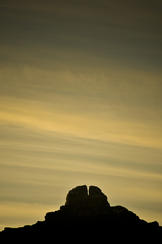Towerkop History
In the Klein Swartberg, the 2 189 metre-high Towerkop dominates the area around Ladismith and is easily recognised by its twin towers. Although mountaineering in this country was born, naturally enough, on Table Mountain, it was on Towerkop one Sunday in 1885 that the story of rock climbing begins.

Nineteen-year-old Gustav Nefdt led five other young Ladismith men in secrecy up the mountain. None had any climbing experience and, without climbing equipment, only Nefdt managed to scale the western tower.
The townsfolk would not believe their story, declaring after a reconnaissance of Towerkop that it could only be scaled by lizards, and they were not far wrong. To vindicate his honour Nefdt once again tackled Towerkop's face and by using laybacks, hand jamming and other techniques of the modern climber, he again stood on top of the mountain. He then had to lower a rope to bring up the rest of the party.
To put this amazing achievement in perspective, Nefdt's route up the overhanging crack was attempted many times by generations of the country's best climbers. It was not until 1947 that he was finally followed by Harry Currey, Brian Russell, Ted Keen and Denys Williamson. After an unsuccessful attempt in 1931, famous Cape climber Bert Berrisford said: “Towerkop is an extraordinary mountain, and in many ways an appalling and terrifying one... Where one expects to find a saving grip none exists – the mountain seems to hold out no friendly hand.”
Did You Know: Although Towerkop (2 189 m), from a distance, seems to be the tallest peak in the Swartberg ranges, it is actually overshadowed by both Seweweekspoort Peak (2 325 m) and Matroosberg Peak (2 249 m); the latter is close to Ceres in the Boland.